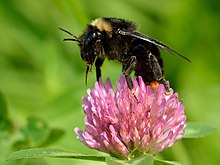Bombus rupestris
| Bombus rupestris | |
|---|---|

| |
| Male | |

| |
| Female | |
| Scientific classification | |
| Domain: | Eukaryota |
| Kingdom: | Animalia |
| Phylum: | Arthropoda |
| Class: | Insecta |
| Order: | Hymenoptera |
| Family: | Apidae |
| Genus: | Bombus |
| Subgenus: | Psithyrus |
| Species: | B. rupestris
|
| Binomial name | |
| Bombus rupestris (Fabricius, 1793)
| |
| Synonyms | |
| |
Bombus rupestris is a species of cuckoo bumblebee present in most of Europe except Iceland and the Balkans. It is also found in Turkey.[3]
Description
The female is much larger than the male; she has a length of 20–25 mm (0.79–0.98 in), while the drone usually is not more than 16 mm (0.63 in).[4] The bumblebee is black, with the last abdominal segments coloured orange-red.[5]
Due to its parasitic lifestyle, no workers exist.
Behaviour
Bombus rupestris is found in flower-rich habitats, such as meadows and along hedgerows.[4] The bumblebee parasitizes the nests of the red-tailed bumblebee, B. lapidarius, whose queen is killed or subjugated.[5]
References
- ^ Rasmont, P.; Roberts, S.; Cederberg, B.; Radchenko, V.; Michez, D. "Bombus rupestris". The IUCN Red List of Threatened Species 2015.
{{cite web}}:|access-date=requires|url=(help); Missing or empty|url=(help) - ^ "Bombus rupestris (Fabricius, 1793)". Biolib.cz. Retrieved 4 July 2012.
- ^ Discover Life. "Discover Life map of Bombus rupestris". Retrieved 28 February 2009.
- ^ a b Jim Lindsey (retired professor of Biostatistics). "Bombus rupestris". Archived from the original on March 13, 2008. Retrieved 28 February 2009.
{{cite web}}: Unknown parameter|deadurl=ignored (|url-status=suggested) (help) - ^ a b Dr Brian Nelson, Ulster Museum. "Bombus (Psithyrus) rupestris – a cuckoo bumblebee". National Museums Northern Ireland. Retrieved 28 February 2009.

